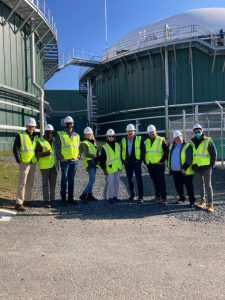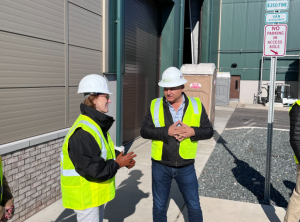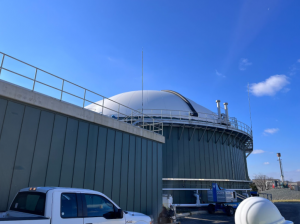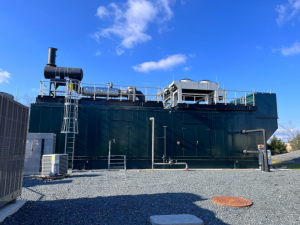Food as Fuel: Maryland Energy Administration Tours Bioenergy Devco Renewable Energy Plant in Jessup
Jessup, MD – Clean energy innovation has planted its roots in southeastern Howard County.
The Maryland Energy Administration (MEA) toured the newly-constructed Bioenergy Devco food and organic waste processing plant on Thursday, November 17, in Jessup. Now operational, this facility creates renewable energy from food and other organic wastes that have traditionally been discarded in landfills. Bioenergy Devco’s solution is actively working to address that problem in a way that helps Maryland’s food industry become more sustainable while creating local clean energy jobs for Marylanders.
“We often don’t think about what happens to our food scraps once we throw them away,” said Dr. Mary Beth Tung, Director of MEA, “This facility changes the game. It takes trash and turns it into something useful – clean, renewable energy that helps meet our state’s energy and environmental goals.”
Above: Dr. Mary Beth Tung, Director of the Maryland Energy Administration, speaks with Bioenergy Devco Founder and CEO Shawn Kreloff.
Food and other organic wastes have mostly been sent to landfills in the past, where they naturally decompose. This process releases methane, a harmful greenhouse gas that’s ten times more potent than carbon dioxide. But, if captured, it can be used as fuel to power and heat our homes and businesses as a renewable energy resource. That’s exactly what’s happening at Bioenergy Devco’s Jessup plant.
The process that creates the methane that is then captured at the plant is very similar to what happens when our food gets digested. Tiny microbes break down the food scraps and other organic matter. Methane is produced as they do this in a process called anaerobic digestion, meaning without the presence of oxygen. This is the same process that happens inside the stomachs of humans and other animals. The equipment used in this process at the Bioenergy Devco facility is called an anaerobic digester – and it really is like a big, artificial stomach. The methane that the anaerobic digester produces is often referred to as “biogas” or “renewable natural gas,” because it comes from biological sources and is therefore renewable, unlike gas produced from traditional fossil sources.
The biogas that Bioenergy Devco produces is first sent through a process to clean it of any impurities before it is sent out to the local gas utility’s pipeline. This means that the utility can rely less on fossil fuels and more on renewable biogas. This helps reduce greenhouse gas emissions, combat climate change, and helps get Maryland further into its clean energy future.
Above: One of the anaerobic digester systems at the Bioenergy Devco Jessup, MD site.
Local food producers, restaurants, and others are now actively diverting their food wastes from landfills and sending them to the Jessup facility for processing, which helps them meet their own sustainability goals. Not only that, this type of solution can and is expected to be replicated and scaled across Maryland.
“This process works. We’re already looking at expanding our operations,” said Shawn Kreloff, Founder and CEO of Bioenergy Devco.
But the innovation doesn’t stop there. The plant has also invested in ensuring that the energy needed to power it is affordable, sustainable, and reliable. This is done through the use of a combined heat and power (CHP) system that was installed adjacent to the main facility on the project site. MEA provided Bioenergy Devco with a $467,500 CHP Grant from its CHP Grant Program, funded by the Maryland Strategic Energy Investment Fund (SEIF), to help with the cost.
CHP systems are highly-efficient energy systems that maximize the use of the fuel that runs them by producing electricity and usable heat energy at the same time. This differs from electricity provided from the grid and heat energy produced separately in more traditional systems like boilers. Together, these traditional methods of obtaining energy are only about 50% efficient. CHP systems, on the other hand, operate at and often exceed about 75% efficiency. This means that less fuel is needed overall to produce the same amount of energy that would otherwise be provided by the electric utility and boilers. This makes CHP good for sustainability while at the same time keeping operating expenses lower.
Above: The CHP system that powers and provides useful heat energy to the site.
And it’s also resilient. The CHP system is configured to be able to restart after a utility outage and continue providing power to the Bioenergy Devco site so that it can keep running. This is vitally important, because without electricity and heat to run the anaerobic digester, the microbes needed to make the process happen will die. That would result in thousands of dollars lost in wasted material. The CHP system helps prevent this from happening, keeping the lights on, the system running, and Marylanders working.
The Bioenergy Devco site is a great example of the impact that collaboration can have in meeting multiple goals at once. It combines biology, chemistry, engineering, logistics, energy, and so many other subject areas to create a localized, replicable, and scalable solution that will help our state become more sustainable, energy efficient, and resilient while growing our clean energy economy.
To learn more about MEA and its suite of energy programs, please visit us at Energy.Maryland.gov.
Follow us on social media: LinkedIn | Facebook | Twitter





 1-888-373-7888
1-888-373-7888 233733
233733